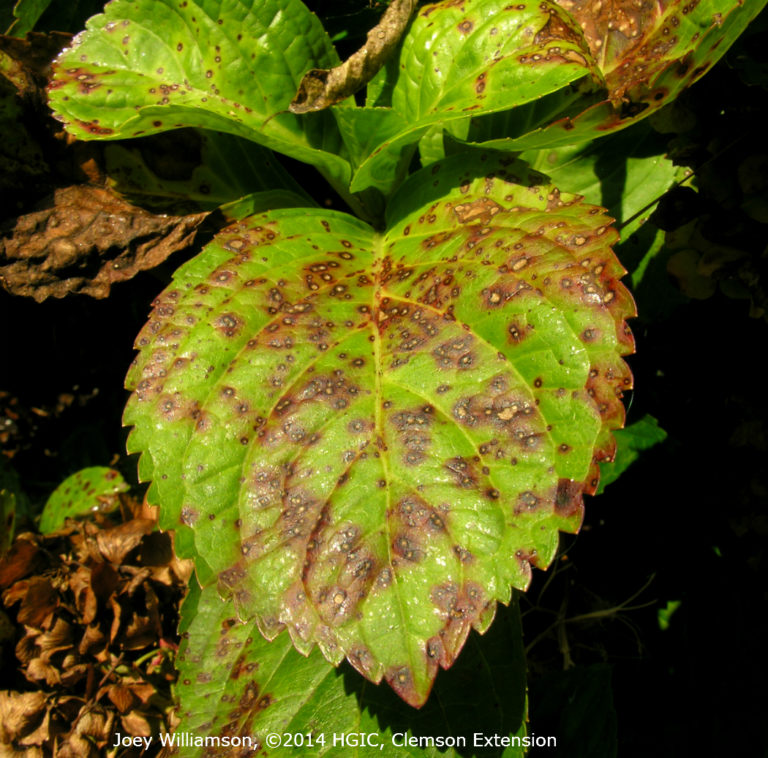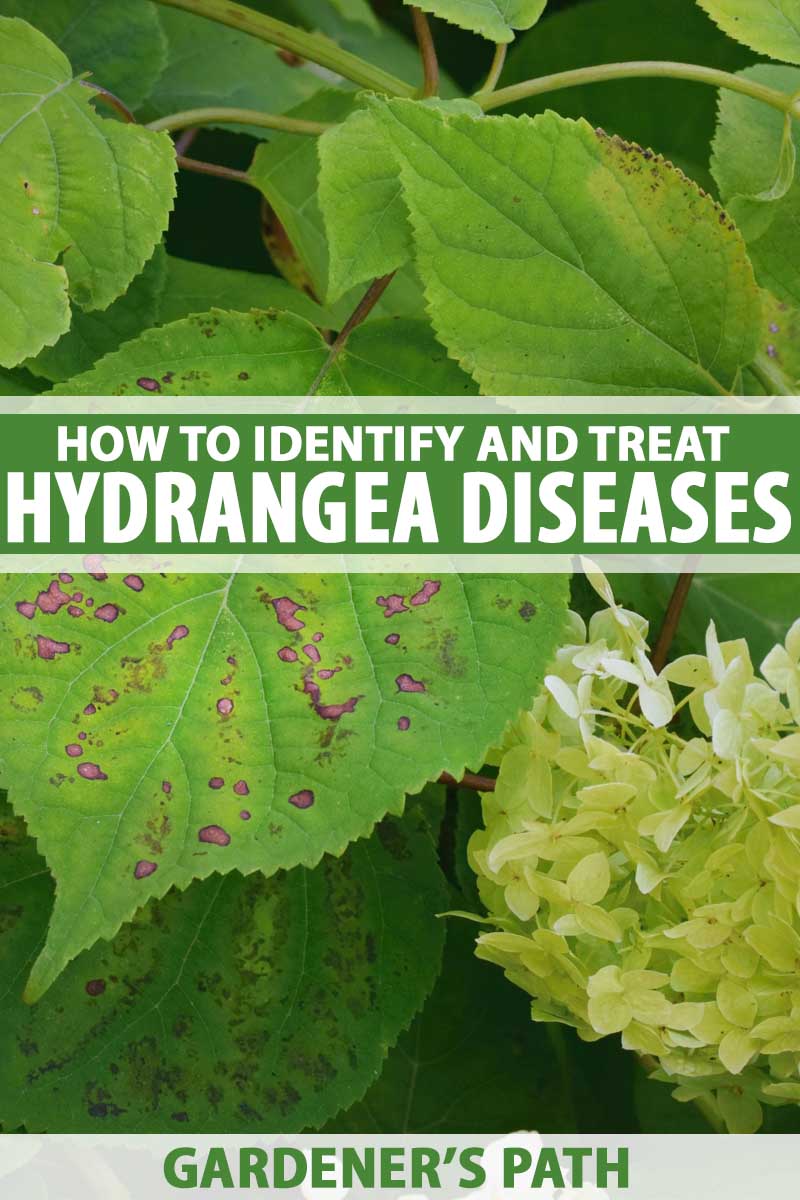The best fungicide for hydrangea leaf spot is a copper-based fungicide. It effectively controls the disease and helps prevent further damage to the leaves.
Hydrangeas are popular flowering plants known for their beautiful and vibrant blooms. However, they are susceptible to various diseases, including leaf spot. Leaf spot is a common fungal disease that causes dark spots to appear on the leaves, leading to discoloration and eventually leaf drop.
To combat this problem, using a copper-based fungicide is highly recommended. Copper-based fungicides work by inhibiting the growth of the fungus and preventing its spread. They are effective in controlling leaf spot and other fungal diseases on hydrangeas.
When applying the fungicide, make sure to follow the instructions on the product label carefully. This will ensure proper application and maximum effectiveness. Regularly monitoring your hydrangeas for signs of leaf spot and promptly treating it with a copper-based fungicide can help keep your plants healthy and thriving.
Understanding Hydrangea Leaf Spot
Hydrangea leaf spot is a common problem that many gardeners face. It is important to understand the causes and symptoms of this condition in order to effectively treat and prevent it.
Leaf spot is typically caused by fungal infections, such as Cercospora, which thrive in warm and humid environments. Overhead watering, poor air circulation, and overcrowding can also contribute to the development of leaf spot.
Symptoms of hydrangea leaf spot include the appearance of small, dark spots on the leaves, which may grow in size and merge together. As the infection progresses, the leaves may turn yellow and eventually fall off. It is crucial to identify leaf spot early on to prevent further spread and damage to the plant.
To control hydrangea leaf spot, it is recommended to practice good garden hygiene by removing and disposing of infected leaves. Fungicides containing active ingredients such as chlorothalonil or mancozeb can also be effective in treating leaf spot.
Applying these fungicides according to the manufacturer’s instructions can help protect the plant from further infection.
Choosing The Right Fungicide
When choosing the best fungicide for hydrangea leaf spot, there are several factors to consider. The type of fungicide plays a crucial role in its effectiveness. Contact fungicides act on the surface of the plant, while systemic fungicides are absorbed into the plant tissue.
It’s important to select a fungicide that targets the specific type of fungus causing the leaf spot on hydrangeas. Additionally, consider the application method and the severity of the leaf spot. Consulting with a gardening expert can help in selecting the most suitable fungicide for hydrangea leaf spot.
Top Picks For Hydrangea Leaf Spot
| Fungicide | Main Ingredient | Price |
|---|---|---|
| Fungicide A | Chlorothalonil | $15 |
| Fungicide B | Azoxystrobin | $20 |
| Fungicide C | Mancozeb | $18 |
If you are looking for the best fungicide for hydrangea leaf spot, consider these top picks:
- Fungicide A contains chlorothalonil as its main ingredient and is a cost-effective option at $15.
- Fungicide B contains azoxystrobin and is a slightly more expensive option at $20.
- Fungicide C contains mancozeb and is priced at $18.
Each of these fungicides has been shown to effectively control hydrangea leaf spot. When applying fungicides, be sure to follow the instructions on the label carefully and use protective gear to avoid any potential hazards.

Credit: union.ces.ncsu.edu
Application Tips
When applying fungicide for hydrangea leaf spot, it’s crucial to consider the proper timing. It’s best to apply the fungicide in the early morning or late afternoon to avoid evaporation. Additionally, it’s important to apply the fungicide when the weather forecast predicts a stretch of dry days.
Proper timing ensures the fungicide has enough time to adhere to the leaves and do its job effectively. Moreover, using correct application techniques is essential for success. Be sure to cover the leaves thoroughly, including the underside, and follow the manufacturer’s instructions for the best results.
Preventive Measures
Cultural Practices: Keeping your hydrangeas healthy and strong is the first step to preventing leaf spot. Make sure to plant them in well-draining soil and in a location that receives adequate sunlight. Regular watering and fertilization will also help keep your plants healthy.
Hydrangea Maintenance Tips: Proper pruning can help prevent the spread of leaf spot. Remove any infected leaves or branches and dispose of them properly. It’s also important to clean your gardening tools regularly to prevent the spread of disease.
| Product Name | Type of Fungicide | Application |
|---|---|---|
| Daconil Fungicide | Chlorothalonil | Spray directly on leaves every 7-14 days |
| Bonide Fung-onil | Chlorothalonil | Spray directly on leaves every 7-14 days |
| Organocide Plant Doctor | Organic | Spray directly on leaves every 7-14 days |
Important Note: Always read and follow the instructions on the fungicide label carefully. Wear protective clothing and gloves when applying fungicides, and avoid spraying on windy days to prevent drift.
:max_bytes(150000):strip_icc()/hydrangea_leaf_spot-2000-fbde36b35a954aa8b922639bc699fb37.jpg)
Credit: www.southernliving.com
Expert Advice On Fungicide Use
Hydrangeas are a popular choice for gardeners, but leaf spot can be a common problem. To combat this, using a fungicide is often necessary. However, it’s important to use the right one and follow certain guidelines.
Dos:
- Choose a fungicide specifically labeled for hydrangea leaf spot.
- Apply the fungicide according to the label instructions, including the recommended amount and frequency.
- Apply the fungicide preventatively before symptoms appear, or at the first sign of leaf spot.
Don’ts:
- Use a general fungicide not labeled for hydrangea leaf spot.
- Apply the fungicide incorrectly or at the wrong time.
- Overuse fungicide, as this can lead to resistance and other problems.
Common mistakes to avoid include using too little or too much fungicide, not following the label instructions, and waiting too long to apply the fungicide. By following these guidelines, you can effectively control hydrangea leaf spot and keep your plants healthy and beautiful.
Monitoring Hydrangea Health
Regular inspections are crucial for monitoring the health of hydrangeas. Look for signs of improvement in the foliage to assess the effectiveness of the fungicide treatment. Keep an eye out for any new symptoms of leaf spot and take proactive measures to address them promptly.
Additionally, ensure that the plants are receiving adequate watering and are not experiencing any stress due to environmental factors. By maintaining a vigilant approach, you can protect your hydrangeas from leaf spot and promote their overall well-being.

Credit: gardenerspath.com
Frequently Asked Questions
What Fungicides Are Used To Control Leaf Spot?
Several fungicides can be used to control leaf spot, including chlorothalonil, copper-based fungicides, propiconazole, and myclobutanil. The choice of fungicide depends on the type of leaf spot and the severity of the infection. It is best to consult a professional to determine the most effective fungicide for your specific situation.
What Is A Homemade Fungicide For Hydrangeas?
You can make a homemade fungicide for hydrangeas by mixing 1 teaspoon of baking soda with 1 quart of water. Add a few drops of dish soap and spray the solution on the plant. Repeat every 7-10 days as needed.
What Is The Best Fungicide For Cercospora Leaf Spot?
The best fungicide for Cercospora leaf spot is chlorothalonil. It effectively controls the disease and prevents further spread. Apply according to the manufacturer’s instructions for best results.
What Is The Fungicide For Bacterial Leaf Spot?
Copper-based fungicides effectively treat bacterial leaf spots in plants. These products are widely available and can be applied to the affected areas.
Conclusion
To effectively combat hydrangea leaf spot, choosing the best fungicide is crucial. By targeting the disease-causing pathogens, a suitable fungicide can protect your hydrangeas from further damage and promote their overall health. Remember to follow the instructions carefully and apply the fungicide at the recommended intervals.
With the right fungicide, you can ensure the longevity and beauty of your hydrangeas for years to come.
- 20 Best Indoor Kitchen Plants for Freshness, Beauty, and Health - November 9, 2024
- 20 Stunning Indoor Hanging Plants to Transform Your Space Instantly! - November 2, 2024
- How to Propagate Monstera Plant? A Complete Step-by-Step Guide! - October 24, 2024
